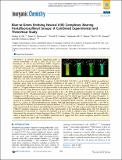Blue-to-green emitting neutral Ir(III) complexes bearing pentafluorosulfanyl groups : a combined experimental and theoretical study
Abstract
A structure-property relationship study of neutral heteroleptic ( 1 and 2 , [Ir(C^N)2(L^X)]) and homoleptic ( 3 and 4 , fac-[Ir(C^N)3]) Ir(III) complexes [where L^X = anionic 2,2,6,6-tetramethylheptane-3,5-dionato-κO3,κO6 (thd) and C^N = a cyclometalating ligand bearing a pentafluorosulfanyl (-SF5) electron-withdrawing group (EWG) at C4 (H L1 ) and C3 (H L2 ) positions of the phenyl moiety] is presented. These complexes have been fully structurally characterised, including by single crystal X-ray diffraction, and their electrochemical and optical properties have also been extensively studied. While complexes 1 ([Ir( L1 )2(thd)]), 3 (Ir( L1 )3) and 4 (Ir( L2 )3) exhibit irreversible first reduction waves based on the pentafluorosulfanyl substituent in the range of -1.71 V to -1.88 V (vs. SCE), complex 2 ([Ir( L2 )2(thd)]) exhibits a quasi-reversible pyridineC^N-based first reduction wave that is anodically-shifted at -1.38 V. The metal+C^N ligand oxidation waves are all quasi-reversible in the range of 1.08-1.54 V (vs. SCE). The optical gap, determined from the lowest energy absorption maxima, decreases from 4 to 2 to 3 to 1 and this trend is consistent with the Hammett behaviour (σm/σp with respect to the metal-carbon bond) of the –SF5 EWG. In degassed acetonitrile, for complexes 2 - 4 , introduction of the -SF5 group produced a blue-shifted emission (λem = 484-506 nm) compared to reference complexes [Ir(ppy)2(acac)], R1 (where acac = acetylacetonato) (λem = 528 nm in MeCN), [Ir(CF3-ppy)(acac)], R3 (where CF3-ppy = 2-(4-(trifluoromethyl)phenyl)pyridine) (λem = 522 nm in DCM) and [Ir(CF3-ppy)3], R8 (λem = 507 nm in MeCN). The emission of complex 1 , by contrast, was modestly red-shifted (λem = 534 nm). Complexes 2 and 4 , where the –SF5 EWG is substituted para to the Ir-Cppy bond are efficient phosphorescent emitters, with high photoluminescence quantum yields (ΦPL = 58-79% in degassed MeCN solution) and microsecond emission lifetimes (τε = 1.35-3.02 μs). Theoretical and experimental observations point towards excited states that are principally ligand-centered (3LC) in nature, but with a minor metal-to-ligand charge-transfer (3MLCT) transition component, as a function of the regiochemistry of the pentafluorosulfanyl group. The 3LC character is predominant over the mixed 3CT character for complexes 1 , 2 and 4 while in complex 3 , there is exclusive 3LC character as demonstrated by unrestricted Density Functional Theory (DFT) calculations. The short emission lifetimes and reasonable ΦPL values in doped thin film (5 wt% in PMMA), particularly for 4 , suggest that these neutral complexes would be attractive candidate emitters in organic light-emitting diodes.
Citation
Pal , A K , Henwood , A F , Cordes , D B , Slawin , A M Z , Samuel , I D W & Zysman-Colman , E 2017 , ' Blue-to-green emitting neutral Ir(III) complexes bearing pentafluorosulfanyl groups : a combined experimental and theoretical study ' , Inorganic Chemistry , vol. 56 , no. 13 , pp. 7533–7544 . https://doi.org/10.1021/acs.inorgchem.7b01075
Publication
Inorganic Chemistry
Status
Peer reviewed
ISSN
0020-1669Type
Journal article
Description
EZ-C acknowledges the University of St Andrews for financial support. The authors are grateful to the EPSRC for financial support from grant EP/M02105X/1, DTG grants: EP/J500549/1, EP/K503162/1, EP/L505097/1. The authors are also grateful to the European Research Council (321305) for support. IDWS is a Royal Society Wolfon Research Merit Award holder.Collections
Items in the St Andrews Research Repository are protected by copyright, with all rights reserved, unless otherwise indicated.

